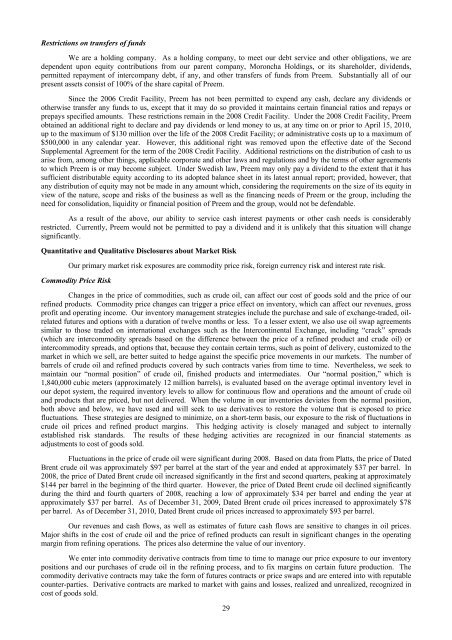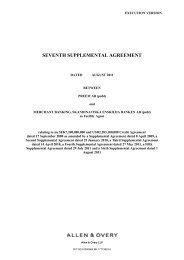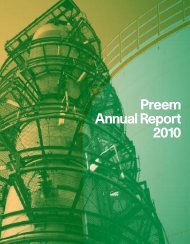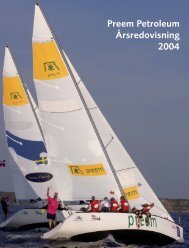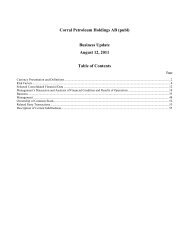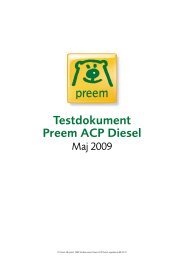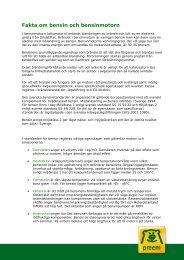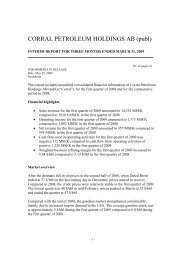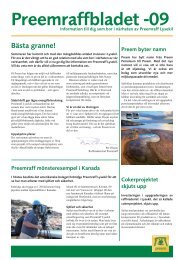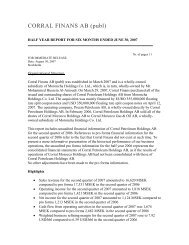Restrictions on transfers of fundsWe are a holding company. As a holding company, to meet our debt service and other obligations, we aredependent upon equity contributions from our parent company, Moroncha Holdings, or its shareholder, dividends,permitted repayment of intercompany debt, if any, and other transfers of funds from <strong>Preem</strong>. Substantially all of ourpresent assets consist of 100% of the share capital of <strong>Preem</strong>.Since the 2006 Credit Facility, <strong>Preem</strong> has not been permitted to expend any cash, declare any dividends orotherwise transfer any funds to us, except that it may do so provided it maintains certain financial ratios and repays orprepays specified amounts. These restrictions remain in the 2008 Credit Facility. Under the 2008 Credit Facility, <strong>Preem</strong>obtained an additional right to declare and pay dividends or lend money to us, at any time on or prior to April 15, 2010,up to the maximum of $130 million over the life of the 2008 Credit Facility; or administrative costs up to a maximum of$500,000 in any calendar year. However, this additional right was removed upon the effective date of the SecondSupplemental Agreement for the term of the 2008 Credit Facility. Additional restrictions on the distribution of cash to usarise from, among other things, applicable corporate and other laws and regulations and by the terms of other agreementsto which <strong>Preem</strong> is or may become subject. Under Swedish law, <strong>Preem</strong> may only pay a dividend to the extent that it hassufficient distributable equity according to its adopted balance sheet in its latest annual report; provided, however, thatany distribution of equity may not be made in any amount which, considering the requirements on the size of its equity inview of the nature, scope and risks of the business as well as the financing needs of <strong>Preem</strong> or the group, including theneed for consolidation, liquidity or financial position of <strong>Preem</strong> and the group, would not be defendable.As a result of the above, our ability to service cash interest payments or other cash needs is considerablyrestricted. Currently, <strong>Preem</strong> would not be permitted to pay a dividend and it is unlikely that this situation will changesignificantly.Quantitative and Qualitative Disclosures about Market RiskOur primary market risk exposures are commodity price risk, foreign currency risk and interest rate risk.Commodity Price RiskChanges in the price of commodities, such as crude oil, can affect our cost of goods sold and the price of ourrefined products. Commodity price changes can trigger a price effect on inventory, which can affect our revenues, grossprofit and operating income. Our inventory management strategies include the purchase and sale of exchange-traded, oilrelatedfutures and options with a duration of twelve months or less. To a lesser extent, we also use oil swap agreementssimilar to those traded on international exchanges such as the Intercontinental Exchange, including “crack” spreads(which are intercommodity spreads based on the difference between the price of a refined product and crude oil) orintercommodity spreads, and options that, because they contain certain terms, such as point of delivery, customized to themarket in which we sell, are better suited to hedge against the specific price movements in our markets. The number ofbarrels of crude oil and refined products covered by such contracts varies from time to time. Nevertheless, we seek tomaintain our “normal position” of crude oil, finished products and intermediates. Our “normal position,” which is1,840,000 cubic meters (approximately 12 million barrels), is evaluated based on the average optimal inventory level inour depot system, the required inventory levels to allow for continuous flow and operations and the amount of crude oiland products that are priced, but not delivered. When the volume in our inventories deviates from the normal position,both above and below, we have used and will seek to use derivatives to restore the volume that is exposed to pricefluctuations. These strategies are designed to minimize, on a short-term basis, our exposure to the risk of fluctuations incrude oil prices and refined product margins. This hedging activity is closely managed and subject to internallyestablished risk standards. The results of these hedging activities are recognized in our financial statements asadjustments to cost of goods sold.Fluctuations in the price of crude oil were significant during 2008. Based on data from Platts, the price of DatedBrent crude oil was approximately $97 per barrel at the start of the year and ended at approximately $37 per barrel. In2008, the price of Dated Brent crude oil increased significantly in the first and second quarters, peaking at approximately$144 per barrel in the beginning of the third quarter. However, the price of Dated Brent crude oil declined significantlyduring the third and fourth quarters of 2008, reaching a low of approximately $34 per barrel and ending the year atapproximately $37 per barrel. As of December 31, 2009, Dated Brent crude oil prices increased to approximately $78per barrel. As of December 31, 2010, Dated Brent crude oil prices increased to approximately $93 per barrel.Our revenues and cash flows, as well as estimates of future cash flows are sensitive to changes in oil prices.Major shifts in the cost of crude oil and the price of refined products can result in significant changes in the operatingmargin from refining operations. The prices also determine the value of our inventory.We enter into commodity derivative contracts from time to time to manage our price exposure to our inventorypositions and our purchases of crude oil in the refining process, and to fix margins on certain future production. Thecommodity derivative contracts may take the form of futures contracts or price swaps and are entered into with reputablecounter-parties. Derivative contracts are marked to market with gains and losses, realized and unrealized, recognized incost of goods sold.29
Hedging activities/Hedge of inventoryWe enter into certain derivatives transactions in order to keep price risk exposure and volume exposures withinlimits set out in our risk policy, including a value-at-risk limit on total exposure of $5 million. See “—Tradingactivities.” For example, if we have a long physical exposure (i.e., we have more volume priced oil than the normalposition) we can offset most of the price risk of this long physical exposure by going equally short on derivative contractswith the same (or similar) underlying commodity.As of December 31, 2010, we had a net long derivative position on crude oil and refined products derivativecontracts of 91,000 cubic meters (approximately 0.6 million barrels) off-setting a short physical position. The unrealizedprofit on these contracts was SEK 116.5 million as of December 31, 2010. As of December 31, 2009, we had a net shortderivative position on crude oil (excluding the extraordinary hedge of the normal inventory on crude oil) and refinedproducts derivative contracts of 192,000 cubic meters (approximately 1.2 million barrels), off-setting a long physicalposition. The unrealized profit on these contracts as of December 31, 2009 was SEK 20.2 million. As of December 31,2008, we had a net short derivative position on crude oil and refined products derivative contracts of 338,000 cubicmeters (approximately 2 million barrels) off-setting a long physical position. The unrealized loss on these contracts wasSEK 149 million as of December 31, 2008.Trading activitiesWe also enter into derivative transactions which are unrelated to physical exposure and are therefore classifiedas “speculative.” These transactions are monitored against profit and loss limits set out in our risk policy which do notpermit trading risk greater than $0.5 million per trade. The risk amount limit for the total exposure (based on volumetricdeviation from the normal position distributions) is set at $5 million. To measure the risk amount on our total exposure,we use a value-at-risk model that is updated on a daily basis. As of December 31, 2010 and December 31, 2009, therewas no open position on derivative contracts not treated as a hedge.Foreign Currency RiskFrom time to time, we use forward exchange contracts and, to a lesser extent, currency options and currencyswaps to manage our foreign currency risk. See “—Fluctuations in Foreign Currency Exchange Rates” for a discussionof our exposure to changes in the dollar-krona and euro-krona exchange rates.As of December 31, 2010, our krona-denominated variable-rate indebtedness totaled SEK 7,408 million. As ofDecember 31, 2010, our dollar-denominated variable-rate indebtedness totaled $637 million. As of December 31, 2010,our euro-denominated variable-rate indebtedness totaled €320 million (including short-term and long-term indebtedness).As of December 31, 2010, we had cash and cash equivalents in foreign currencies amounting to SEK364 million, of which the equivalent of SEK 362 million was denominated in dollars and the equivalent of SEK 2 millionwas denominated in euro.The table below presents, as of December 31, 2010, a summary of our current and long-term debt which arederived from our audited consolidated financial statements.December 31, 2010Borrower Current debt Long-term debt Total debt(in millions SEK)Corral Petroleum Holdings ..................................................................... 3,947 1,012 4,959Structurally senior debt<strong>Preem</strong>...................................................................................................... 9,671 — 9,671Subsidiaries of <strong>Preem</strong> ............................................................................. — — —Total....................................................................................................... 13,618 1,012 14,630The table below presents, as of December 31, 2010, a summary of our long-term financial instruments,including their current positions, by functional currency and expected maturity dates, which are derived from our auditedconsolidated financial statements.Payment Due Period30TotalValuePercentage ofTotalLongTerm Debt%EstimatedFair Value2011 2012 2013 2014 2015 2016+(in millions SEK, except %)Krona-denominatedindebtedness as ofDecember 31, 2010:Fixed rate debt—amount due ...... — — — — — — — — —
- Page 2: TABLE OF CONTENTSDisclosure Regardi
- Page 5: which was merged into Preem on Octo
- Page 8 and 9: RISK FACTORSThe risk factors below
- Page 10 and 11: the cost of exploring for, developi
- Page 12 and 13: purchase a minimum of 10% to 20% of
- Page 14 and 15: market price at the time of settlem
- Page 16 and 17: Notes, we would try to obtain waive
- Page 18 and 19: are reasonable grounds for believin
- Page 20 and 21: civil liability, whether or not pre
- Page 22 and 23: SELECTED CONSOLIDATED FINANCIAL DAT
- Page 24 and 25: MANAGEMENT’S DISCUSSION AND ANALY
- Page 26 and 27: Year ended December 31,%2008 2009 C
- Page 28 and 29: arrel in February, increased to app
- Page 30 and 31: (1) Includes sales by our supply an
- Page 32 and 33: SEK 5,519 million, from a loss of S
- Page 34 and 35: Cash flow used in investment activi
- Page 38 and 39: Variable rate debt—amount due .
- Page 40 and 41: As of December 31, 2008, SEK 21,999
- Page 42 and 43: Our StrengthsOur competitive streng
- Page 44 and 45: Lysekil has a total storage capacit
- Page 46 and 47: Unfinished and Blend Stocks........
- Page 48 and 49: Heating Oil .......................
- Page 50 and 51: Business-to-Business DivisionWe pre
- Page 52 and 53: “.nu,” “.org,” “.biz,”
- Page 54 and 55: Energy AB, Huda Trading AB, the Swe
- Page 56 and 57: was incorporated on March 22, 2007,
- Page 58 and 59: RELATED PARTY TRANSACTIONSCapital T
- Page 60 and 61: DESCRIPTION OF CERTAIN INDEBTEDNESS
- Page 62 and 63: effected by the Third Supplemental
- Page 64 and 65: first ranking mortgage certificates
- Page 66 and 67: LEGAL INFORMATIONCorral Petroleum H
- Page 68 and 69: CORRAL PETROLEUM HOLDINGS AB (publ)
- Page 70 and 71: CORRAL PETROLEUM HOLDINGS AB (publ)
- Page 72 and 73: CORRAL PETROLEUM HOLDINGS AB (publ)
- Page 74 and 75: CORRAL PETROLEUM HOLDINGS AB (publ)
- Page 76 and 77: SubsidiariesSubsidiaries are compan
- Page 78 and 79: The refinery installations consist
- Page 80 and 81: of occupational pension insurance,
- Page 82 and 83: Emission rights 2010LysekilGothenbu
- Page 84 and 85: NOTE 2. FINANCIAL RISK MANAGEMENTTh
- Page 86 and 87:
In addition to price risk managemen
- Page 88 and 89:
The fair value of borrowing is calc
- Page 90 and 91:
Reconciliation with the Group’s t
- Page 92 and 93:
The Board members including the Cha
- Page 94 and 95:
NOTE 12. EXPENSES BROKEN DOWN BY TY
- Page 96 and 97:
NOTE 16. EXCHANGE RATE DIFFERENCES
- Page 98 and 99:
Equipment, tools, fixtures and fitt
- Page 100 and 101:
NOTE 23. TRADE AND OTHER RECEIVABLE
- Page 102 and 103:
The change in the fair value of pla
- Page 104 and 105:
Loan conditions, effective interest
- Page 106 and 107:
Capitalized interest cost..........
- Page 108:
SalesDecember 31, 2009AccountsPurch


